Rochester, MN Pollen and Allergy Report for Summer 2023
Pollen Allergy Trends in Rochester, MN
When is pollen lowest in Rochester, MN?

February
Lowest month total PPM
Avg. PPM
When is pollen highest in Rochester, MN?

April
Highest month total PPM
Avg. PPM
How does pollen in Rochester, MN compare to Minnesota?
Rochester has a lower average PPM than the state of Minnesota.
Rochester yearly avg PPM:
Minnesota yearly avg PPM:
How does pollen in Rochester, MN compare to the USA?
Rochester has a higher average PPM than the USA.
Rochester yearly avg PPM:
USA yearly avg PPM:
Is pollen worse this year in Rochester, MN?
Spring 2023 was worse than spring 2022.
Spring 2023 PPM:
Spring 2022 PPM:
Average PPM in Rochester, MN
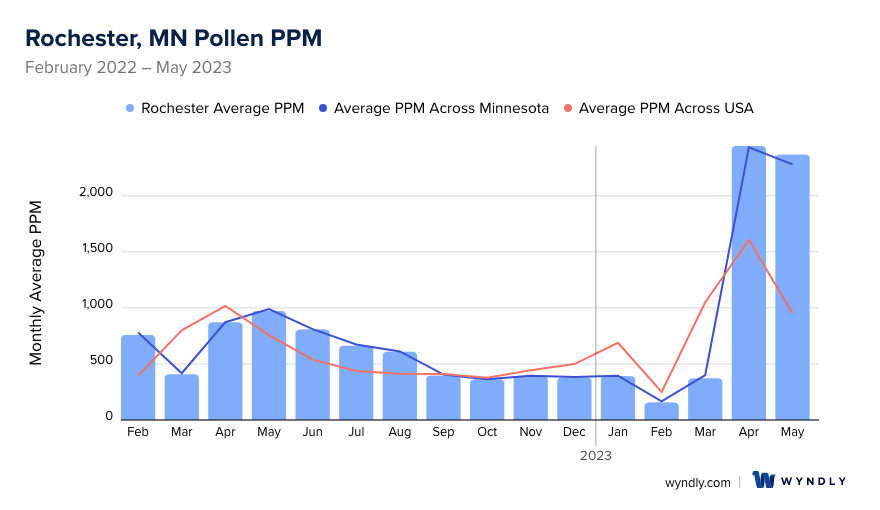

Rochester, MN Pollen and Allergy Breakdown by Month
Grass
When is grass pollen highest in Rochester, MN?
February has the highest grass pollen in Rochester, MN with an average PPM of
When is grass pollen lowest in Rochester, MN?
October has the lowest grass pollen in Rochester, MN with an average PPM of
Tree
When is tree pollen highest in Rochester, MN?
April has the highest tree pollen in Rochester, MN with an average PPM of
When is tree pollen lowest in Rochester, MN?
October has the lowest tree pollen in Rochester, MN with an average PPM of
Weed
When is weed pollen highest in Rochester, MN?
April has the highest weed pollen in Rochester, MN with an average PPM of
When is weed pollen lowest in Rochester, MN?
February has the lowest weed pollen in Rochester, MN with an average PPM of
Rochester, MN Pollen Monthly Breakdown by Pollen Type

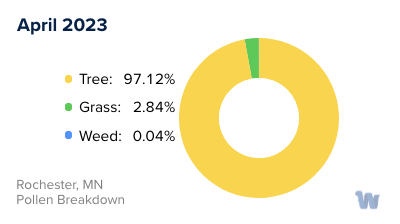
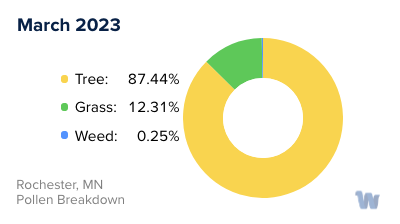
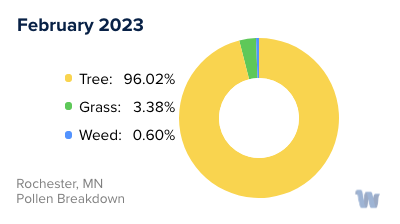
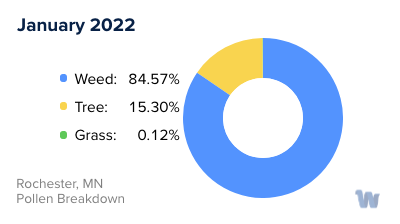




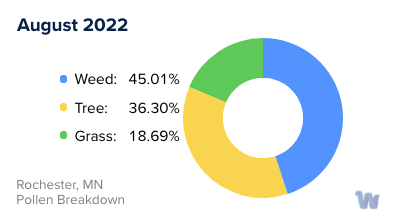


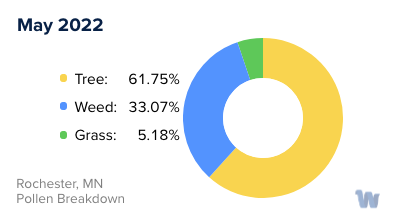


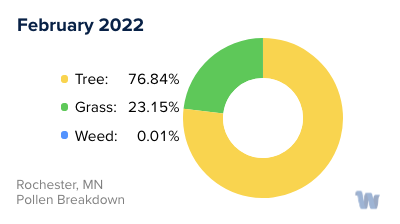
Pollen and Hay Fever in Rochester, MN
Pollen allergies, often colloquially referred to as hay fever, are a common concern for residents of Rochester, Minnesota. In this Midwestern city, the changing seasons bring a myriad of pollen types that can trigger an array of allergy symptoms.
Pollen, the tiny, powdery granules produced by plants for reproduction, floats through the air and can be inhaled, leading to allergic reactions in sensitive individuals. In Rochester, the primary sources of pollen come from trees, grasses, and weeds.
Tree pollen, especially from oak, cedar, and pine, tends to be highest in the spring. As the trees awaken from their winter slumber, they release vast quantities of pollen into the air. These tiny particles are easily carried by the wind, spreading far and wide. For the allergy sufferer, the advent of spring may bring itchy eyes, sneezing, and congestion, all telltale signs of a reaction to tree pollen.
As we transition into the warmth of summer, the grasses take their turn. Common grasses in Rochester such as Kentucky bluegrass, ryegrass, and Timothy grass release their pollen. The late spring to early summer period can be challenging for those sensitive to grass pollen, with symptoms often peaking in June.
As summer fades into fall, weed pollen becomes the primary concern. Ragweed, a plant that thrives in the Midwest, releases its pollen in late summer and fall. This plant is highly allergenic, and it's not uncommon for people who have been fine all year suddenly to find themselves grappling with allergy symptoms in the autumn.
Understanding the types of pollen and their seasons can be beneficial in anticipating when allergy symptoms may flare. This knowledge can help allergy sufferers plan outdoor activities accordingly and take preventive measures to minimize exposure.
Remember, while pollen allergies and hay fever can be uncomfortable and disruptive, they are a natural response to the changing seasons and the diverse plant life that makes Rochester, Minnesota, a unique and vibrant place to live.


